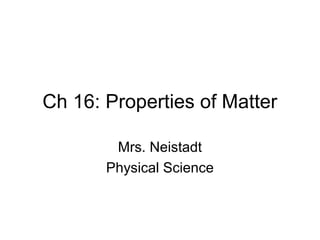
Classification of Matter
- 1. Ch 16: Properties of Matter Mrs. Neistadt Physical Science
- 2. Notes Chapter 16.1 *What is Matter? *Matter is a term used to describe anything that has mass and takes up space.
- 3. Classifying Matter • *Matter is divided into two categories: mixtures and substances. • *Mixtures contain more than one kind of matter. – For example: Cola is a mixture of carbonated water, corn syrup, caramel color, phosphoric acid, natural flavors and caffeine.
- 4. Two Types of Mixtures • *A Homogeneous Mixture is the same throughout. – Examples: unopened cola, gasoline, peanut butter • *A Heterogeneous Mixture has differences throughout a sample. – Examples: chicken noodle soup, salad, rocky road ice cream
- 5. What is a Substance • *A Substance cannot be separated into different kinds of matter by physical methods. (sorting, filtering, heating, cooling) – Example: table salt (sodium + chlorine) – *A substance that contains only ONE type of matter is called an Element. • Sodium is an element, as is chlorine
- 6. Periodic Table of Elements
- 7. What is a compound? • * A Compound is a substance made of two or more elements that cannot be separated by physical means. (sorting, heating, cooling, filtering) • Is saltwater a compound?
- 9. 16.1 Classifying Matter Key Question: How can a homogenous mixture be separated?
- 10. Notes Chapter 16.2 Measuring Matter Daily Question: How do we measure matter? 1. If its liquid: find its volume 2. If its solid: find its mass 3. If its irregular: use the displacement method
- 11. • To find the volume, simply measure in a marked container. • To find mass, use a balance.
- 12. What if the item is an odd shape? • The Displacement Method works to find the mass of irregularly shaped objects.
- 13. What is the volume of the objects?
- 14. How can we determine the amount of matter in a rock? 1. Measuring the mass of the rock on a balance 2. Measuring the volume of the rock by using displacement technique
- 15. Notes Chapter 16.3 DQ: What are the four states of matter? (hint: pg 292) Solid Liquid Gas Plasma
- 16. Molecules and Atoms • *A Molecule is the smallest part of a compound that retains its properties. • *An Atom is the smallest part of an element. • Atoms are more than a trillion times smaller than what we can see with a microscope.
- 17. Atoms are always moving • *At higher temperatures there is more energy- so atoms move faster • *At lower temperatures there is less energy- so atoms move slower • *Temperature influences the changes of state of an atom or molecule.
- 18. States of Matter • *Solid- retains its shape and size; Molecules vibrate, but cannot change position.
- 19. States of Matter • *Liquids- has a definite volume, but no definite shape; molecules can move over and around each other and will fit into whatever container its poured into.
- 20. States of Matter • *Gas- has no definite size or shape; molecules float around freely and will spread out evenly throughout the container
- 21. States of Matter • *Plasma- atoms heated to such high temperature they lose their outer layer of electrons. Not often found on Earth, but makes up 99% of matter in the universe.
- 22. Create a Graph Homogenous Heterogeneous Molecule Element Mixture Mixture
